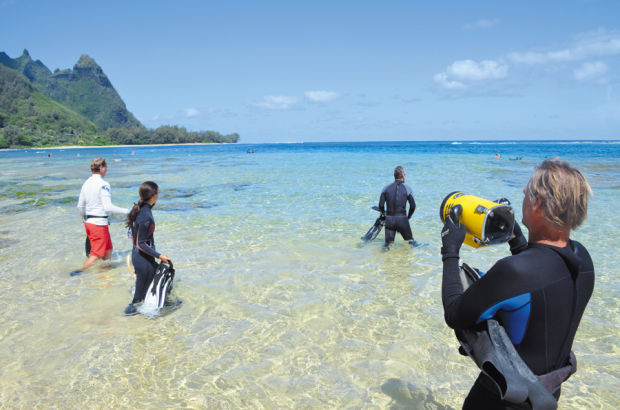LIHU‘E — A team of scientists from the National Oceanic and Atmospheric Administration wrapped up its week-long study of Kaua‘i’s diseased coral reefs Tuesday. Led by NOAA coral disease specialist Bernardo Vargas-Angel, the four-man team arrived on island April 29
LIHU‘E — A team of scientists from the National Oceanic and Atmospheric Administration wrapped up its week-long study of Kaua‘i’s diseased coral reefs Tuesday.
Led by NOAA coral disease specialist Bernardo Vargas-Angel, the four-man team arrived on island April 29 and spent the week collecting data and conducting surveys along Kaua‘i’s North Shore.
“We are pleased to report that dive operations and coral disease surveys off the North Shore of Kaua‘i concluded successfully with a total of 36 sites surveyed,” Vargas-Angel wrote in an email Monday to Terry Lilley, the Hanalei biologist who first alerted experts to the unusual outbreak.
Escorted by Lilley, NOAA focused its study on a number of locations around Waipa, Hanalei, Wainiha Bay and ‘Anini Bay. Their survey method involved laying a 25-meter line across the reef and counting infections within a half-meter of that line, according to Lilley.
On Tuesday, the team completed a final dive at Tunnels reef, one of two locations where the cyanobacterial white coral disease was first documented.
Although the data will require additional analysis, Vargas-Angel wrote “it is clear that a few hot spots of rapid tissue loss disease are discernible among the four locales visited.”
Lilley described the trip as successful and said NOAA was able to cover a large amount of reef in a short period of time.
“Their game plan is to come back in a couple months, sometime this summer, to go back to all the same locations to see how much the disease has spread and how many corals it has killed,” he said.
NOAA’s trip augmented efforts started last year by scientists at the U.S. Geological Survey and the University of Hawai‘i.
In a November 2012 report, Dr. Thierry Work, head of infectious disease for USGS, described the rapidly-spreading disease on Kaua‘i as an “epidemic.” Today, he stands by that diagnosis.
“It’s unlike anything I’ve seen anywhere else,” he said over the phone Tuesday. “What we’re seeing here is truly unprecedented.”
On Monday, Work released an updated report, which detailed his latest findings since a return trip to Kaua‘i in mid-April.
The visit came in response to reports from Lilley that the disease was no longer exclusive to the common rice coral, but had begun targeting other species of Montipora corals, including the blue rice coral.
NOAA is proposing to list 66 coral species under the Endangered Species Act. One of those is the blue rice coral.
“The bottom line,” he said of his findings, “is that the major player in this is this filamentous bacteria, and we’ve shown now that they’re infecting a third species (of Montipora corals).”
Of the four North Shore locations he visited last month, Work said infections were most common at Waipa, where 75 percent of corals sampled were infected with the filamentous bacteria.
“Waipa is a degraded reef with numerous recently-dead urchins, bleached and dying cauliflower corals, bleached rice coral in the shallows, sedimentation, low visibility and low currents,” he wrote in Monday’s report.
Gross lesions in corals occupied between 5 and 80 percent of the surface of coral colonies, according to Work.
“Rice corals in North Kaua‘i continue to manifest tissue loss associated with filamentous bacteria on a scale not seen elsewhere in Hawai‘i,” Work wrote in the report. “The environmental drivers promoting this process are complex and poorly understood.”
He wrote that while additional research to better understand the phenomenon continues, the best short-term management option may be to improve environmental conditions on reefs.
Work made the analogy to humans with the implementation of clean drinking water and proper sewage disposal, which he wrote “vastly improved the health and well-being of humans.”
“There is a general consensus among coral biologists globally that land use patterns, degradation of coastal wetlands and overfishing contribute to reef degradation. Perhaps these factors should be considered as part of a comprehensive coastal health management plan for the islands.”
While there is no question that this bacteria is killing coral colonies around Kaua‘i, Work is optimistic that positive change can happen. It’s up to the local community to make the hard decisions about what it wants for the future of its reefs, he said.
“When you insult an ecosystem enough, it will go south,” he said. “But it can be reversed.”
• Chris D’Angelo, lifestyle writer, can be reached at 245-0441 or lifestyle@thegardenisland.com.


